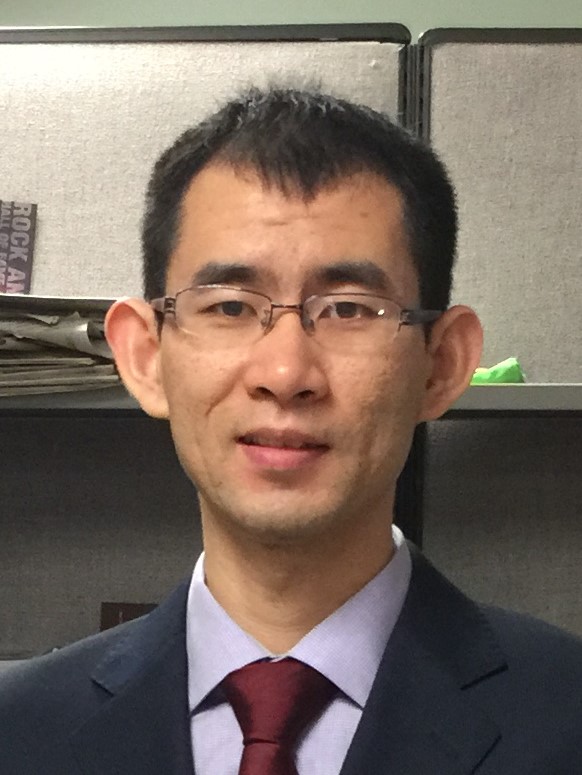June 2017
STAR Newsletter
June 2017 edition
Contents:- Meet New Collaborators: Rutgers
- Call for Summer Sunday Volunteers
- From the Spokesperson
- News from Computing
- Collaboration Members in the Headlines
- STAR arts
A note from the editor: as a collaboration-wide communication tool, this newsletter is set up to allow comments (subject to moderation against abuse), and all STAR Collaborators are welcome to do so! Please keep in mind that some content (including all comments) may be considered internal to the Collaboration and only accessible when logged into Drupal. Documentation is available here.
Meet New Collaborators: Rutgers

In recent years, her group at Rutgers focused on investigating QGP properties with the CMS experiment at LHC by looking at inclusive jets, jet shapes, jet asymmetry, and bottom-quark-tagged jets. Dr. Joel Mazer recently joined Rutgers as a postdoctoral fellow, and he will be building upon his expertise of reaction plane dependent jet-hadron correlations in heavy-ion collisions measured by the ALICE collaboration to contribute to STAR jet measurements. The current Rutgers group is shown in the photo, and in addition to Sevil and Joel (inset photo at far left) includes from left to right: graduate students Ian Laflotte and Raghav Kunnawalkam Elayavalli, and undergraduate students Aditya Verma, Esha Rao, and Thomas Gosart.
Call for Summer Sunday Volunteers
(Gene Van Buren - BNL)

Each summer, there is an Open House of the RHIC facility for the public. This is part of the BNL "Summer Sundays" tour program series that has open houses for various BNL facilities through the summer.
This year's RHIC Summer Sunday will take place on Sunday, August 6th. This is a call for volunteers that will or can be at BNL on that date, and would like to give tours of STAR or otherwise speak with the public. Many visitors are very appreciative of the chance to see and learn what goes on in these otherwise-closed facilities. In addition to the opportunity to explain to a diverse but interested audience what STAR & RHIC are and what we do, volunteers get a free "Polo" type cotton shirt with the BNL logo, as well as a free box lunch.
At the start of the day, we will review some talking points for the tours for first-time volunteers. So please do not feel that a lack of tour-giving experience should prevent you from participating.
The Lab admits people for these tours from 10 am in the morning until 3 pm in the afternoon. Out at STAR this means that we receive visitors from about 10:30 am until about 4:00 pm. We typically get on the order of 1000+ people who come through on these tours. To handle these crowds we usually try and have 8 to 10 tour guides present at STAR.
If you would like to volunteer to help with these tours (even if only for part of the day) please send me an email. Please include in such an email what shirt size you would like (e.g. S, M, L, XL; this year's color can be found here), as well as any preference you have for the box lunch sandwich (tuna, chicken, turkey, vegetarian, ham, or Italian). If you have any questions please feel free to contact me.
Please consider helping out with what can be a rewarding few hours of your time!
From the Spokesperson
(Zhangbu Xu - Spokesperson)
It has been a very busy and productive period of two months!
STAR has prepared and submitted the Beam Use Request for Runs 18 & 19: The BUR highlights two major programs in the next two years: a decisive test of CME with isobar collisions (Zr and Ru), and the inauguration of the BES-II program. In addition, we have requested Au+Au collisions at 27 GeV and a comprehensive fixed target program starting with Run 18.
The BNL RHIC Program Advisory Committee (PAC) met June 15th-16th to review and recommend the Run plan based on our requests. Material and presentations are available here. From the verbal close-out, it is clear that the PAC is very supportive and congratulatory on STAR's progress and its future program. The committee recommends to follow our requests for Run 18 and Run 19. It is also supportive of the forward upgrade and the value of its scientific program. The committee highlighted the importance of future measurements from STAR: CME test from isobar collisions, potential magnetic field sensitivity from global hyperon polarization at 27 GeV, and kurtosis of net-protons from BES-II. The committee recommends STAR to exercise caution and to accompany sufficient documentation for community consumption when releasing these high-profile results. Their written report should be public very soon.
The STAR Collaboration Meeting was held in May 15th-19th at BNL. The STAR Council elected Helen Caines and Zhangbu Xu as co-spokespersons. I would like to take this opportunity to thank everyone for their effort, contribution, and support of the collaboration. It is hard to imagine that three years have gone by since my term as the STAR spokesperson started. We have gone through some rough times together and have made steady progress toward our scientific goals. I would like to thank the management team: Ernst Sichtermann, Helen Caines, Renee Fatemi, Frank Geurts, Gang Wang, Jérôme Lauret, Gene Van Buren, Bill Christie, and Flemming Videbaek for their selfless dedication to the program and leading roles in many area in the collaboration management. For last three years, we have 46 journal publications, 50 PhD graduations, 14 new institutions and 6 detector upgrades installed or under construction. This is something we all should be proud of. Please join me in welcoming Helen Caines from Yale to be co-spokesperson and I am looking forward to a new chapter. We have worked hard to assemble a new team and are close to announcing it and getting to work next month. The STAR Council also voted and accepted three new institutions:
* Rutgers University (Prof. Sevil Salur),
* Fudan University in Shanghai (Dr. Chuan Zheng),
* Heidelberg University (Prof. Norbert Herrman).
Congratulations and welcome! You can learn more about the Rutgers group in their contribution to this Newsletter. The Council meeting agenda, material, and meeting minutes are available here.
The annual RHIC/AGS Users’ Meeting was held on June 20th-23rd, 2017. It is a celebratory event of RHIC/AGS achievements in conjunction with 70 years of BNL discoveries and a century of Upton service. We also had an opportunity to hear and discuss budget news with Tim Hallman (view his presentation here). It was emphasized that “It’s a process informed by information gathering”, and “Delivering exciting discoveries, important scientific knowledge and technological advances is what we do. We need to stay focused and continue to deliver these outcomes for the nation”. The community is very much concerned about the outlook and will continue to engage in promoting the science. Congratulations go to Prashanth Shanmuganathan (Ph.D. Advisor Declan Keane, Kent State) and Zilong Chang (Ph.D. Advisor Carl Gagliardi, Texas A&M University) for winning the RHIC/AGS Users Thesis awards. For details, please see their theses as noted in the next article in this Newsletter. I would also like to congratulate the following 11 new PhD graduates in the last two months (please send me a note if I missed anyone):
* Kunsu Oh from Pusan;
* Xu Wang from SDU;
* Yifei Xu, Zhengqiao Zhang and Long Ma from SINAP;
* Guangnan Xie, Long Zhou and Qian Yang from USTC;
* Xiaozhi Bai and Ji Xu from CCNU;
* Stephen Horvat from Yale.
A STAR regional meeting is being held at Warsaw University of Technology on June 27th-29th, 2017. The focus of the meeting is on heavy-flavor production, jets, correlations and diffractive physics. The attendees include STAR group members from Czech Technical University at Prague, Nuclear Physics Institute of the Czech Academy of Science, AGH University of Science and Technology in Krakow, and Warsaw University of Technology. It is always important and exciting to see many students (including undergraduates and masters students) and young scientists attending the meeting and presenting their progress. More details will come in the next Newsletter.
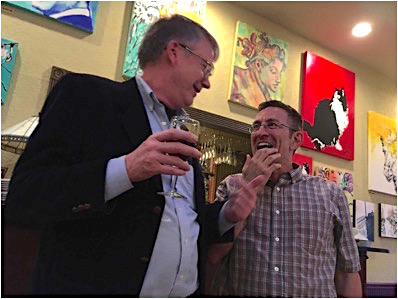
 Jim Thomas recently organized a happy gathering for Stephen Trentalange’s retirement (UCLA) at Caruso's Restaurant (see photos at right), with Tim delivering a certificate of appreciation from DOE. Steve has been an exemplary scientist with decades of service and achievements. Steve has dedicated his scientific effort for the last twenty years in STAR serving as project manager and on-call expert for BEMC, BSMD, and FMS, spin convenor, and mentor to many young scientists. It is always a pleasure chatting with him about science. I will always remember how shocked I was when he started to recite an excerpt from “Dream of the Red Chamber” during a lunch at the BNL cafeteria. Steve, thank you for your excellent service and well-deserved retirement. I am hoping that you stick around for a little longer.
Jim Thomas recently organized a happy gathering for Stephen Trentalange’s retirement (UCLA) at Caruso's Restaurant (see photos at right), with Tim delivering a certificate of appreciation from DOE. Steve has been an exemplary scientist with decades of service and achievements. Steve has dedicated his scientific effort for the last twenty years in STAR serving as project manager and on-call expert for BEMC, BSMD, and FMS, spin convenor, and mentor to many young scientists. It is always a pleasure chatting with him about science. I will always remember how shocked I was when he started to recite an excerpt from “Dream of the Red Chamber” during a lunch at the BNL cafeteria. Steve, thank you for your excellent service and well-deserved retirement. I am hoping that you stick around for a little longer.
Run 17 has completed. It has been another excellent data-taking fest. We have exceeded most of our goals for p+p at 510 GeV, have taken Au+Au collisions at a new energy of 54.4 GeV, and acquired a dataset for forward π0 using RHICf instrumentation. During this Run, we have also commissioned several components of the iTPC (SAMPA electronics), eTOF (prototype readout, DAQ interface and modules), and 1/8th of the final EPD. The EPD has shown impressive performance. Also, two iTPC sectors with padplanes bound on strongbacks at LBL have arrived at SDU on June 5th, and construction of first complete iTPC sector has started at SDU.
News from Computing
(Jérôme Lauret - Software & Computing Leader)
As highlighted in the Spokesperson Message, the BNL RHIC Program Advisory Committee (PAC) met June 15th-16th and progress from STAR data productions as well as follow-ups from last year's findings were asked to be presented. The committee was very pleased to hear that we are, at this stage, only a few months away from completing all of our past data production campaigns (at least, a first pass) thanks to resources STAR has successfully used at very high efficiency. As illustrated in our BUR document (SN0670 : STAR Collaboration Beam Use Request for run 18 and run 19) and also reported at the last STAR Collaboration Meeting You do not have access to view this node (May 2017), our data production efficiencies are at the level of 95% efficiency or more (95%-97% at NERSC/Cori, and 97% at Dubna). The massive resource allocation at NERSC/Cori and the productions at Dubna are allowing respectively a full reproduction pass of the d+Au 200 GeV (st_physics) to address an MTD code issue and the use (in the new production) of the 3D BeamLine constraint method as well as (Dubna) the production of full smaller datasets, such as the 62, 39, and 20 GeV d+Au energy scan, leaving the RACF farm for more lengthy productions and first pass processing. A reminder that Embedding at NERSC/Cori was also successfully tested, opening new avenues for efficiency corrections to be done expeditiously.
Embedding and simulation with misalignments also remains a focus of the Software & Computing Team efforts. Following our understanding with the HFT subsystem group that this is a fundamental need, we have recently progressed on our own to the point of measuring realistic efficiencies in cosmic ray simulations.
As you may have seen, the RACF has announced we have reached the 100 PetaBytes of recorded data threshold. It is interesting to note that from those 100 PB, STAR raw data is of the order of 31 PB, and STAR DSTs approximately 16 PB. Hence, STAR has contributed to about half of that milestone (see the pie chart below). Much exciting scientific discovery I am sure still awaits our analyzers.
Speaking of acquired data, Run 17 has now ended, alone producing approximately 6 PB of raw data, and we now need to focus on completing the calibration process to move toward data production. We are well underway in calibration readiness and although summer times are not always the best period to focus everyone on completing the "last mile", we are hopeful that selected Run 17 data productions will be possible shortly. Overall, the Run went smoothly for computing.
STAR has prepared and submitted the Beam Use Request for Runs 18 & 19: The BUR highlights two major programs in the next two years: a decisive test of CME with isobar collisions (Zr and Ru), and the inauguration of the BES-II program. In addition, we have requested Au+Au collisions at 27 GeV and a comprehensive fixed target program starting with Run 18.
The BNL RHIC Program Advisory Committee (PAC) met June 15th-16th to review and recommend the Run plan based on our requests. Material and presentations are available here. From the verbal close-out, it is clear that the PAC is very supportive and congratulatory on STAR's progress and its future program. The committee recommends to follow our requests for Run 18 and Run 19. It is also supportive of the forward upgrade and the value of its scientific program. The committee highlighted the importance of future measurements from STAR: CME test from isobar collisions, potential magnetic field sensitivity from global hyperon polarization at 27 GeV, and kurtosis of net-protons from BES-II. The committee recommends STAR to exercise caution and to accompany sufficient documentation for community consumption when releasing these high-profile results. Their written report should be public very soon.
The STAR Collaboration Meeting was held in May 15th-19th at BNL. The STAR Council elected Helen Caines and Zhangbu Xu as co-spokespersons. I would like to take this opportunity to thank everyone for their effort, contribution, and support of the collaboration. It is hard to imagine that three years have gone by since my term as the STAR spokesperson started. We have gone through some rough times together and have made steady progress toward our scientific goals. I would like to thank the management team: Ernst Sichtermann, Helen Caines, Renee Fatemi, Frank Geurts, Gang Wang, Jérôme Lauret, Gene Van Buren, Bill Christie, and Flemming Videbaek for their selfless dedication to the program and leading roles in many area in the collaboration management. For last three years, we have 46 journal publications, 50 PhD graduations, 14 new institutions and 6 detector upgrades installed or under construction. This is something we all should be proud of. Please join me in welcoming Helen Caines from Yale to be co-spokesperson and I am looking forward to a new chapter. We have worked hard to assemble a new team and are close to announcing it and getting to work next month. The STAR Council also voted and accepted three new institutions:
* Rutgers University (Prof. Sevil Salur),
* Fudan University in Shanghai (Dr. Chuan Zheng),
* Heidelberg University (Prof. Norbert Herrman).
Congratulations and welcome! You can learn more about the Rutgers group in their contribution to this Newsletter. The Council meeting agenda, material, and meeting minutes are available here.
The annual RHIC/AGS Users’ Meeting was held on June 20th-23rd, 2017. It is a celebratory event of RHIC/AGS achievements in conjunction with 70 years of BNL discoveries and a century of Upton service. We also had an opportunity to hear and discuss budget news with Tim Hallman (view his presentation here). It was emphasized that “It’s a process informed by information gathering”, and “Delivering exciting discoveries, important scientific knowledge and technological advances is what we do. We need to stay focused and continue to deliver these outcomes for the nation”. The community is very much concerned about the outlook and will continue to engage in promoting the science. Congratulations go to Prashanth Shanmuganathan (Ph.D. Advisor Declan Keane, Kent State) and Zilong Chang (Ph.D. Advisor Carl Gagliardi, Texas A&M University) for winning the RHIC/AGS Users Thesis awards. For details, please see their theses as noted in the next article in this Newsletter. I would also like to congratulate the following 11 new PhD graduates in the last two months (please send me a note if I missed anyone):
* Kunsu Oh from Pusan;
* Xu Wang from SDU;
* Yifei Xu, Zhengqiao Zhang and Long Ma from SINAP;
* Guangnan Xie, Long Zhou and Qian Yang from USTC;
* Xiaozhi Bai and Ji Xu from CCNU;
* Stephen Horvat from Yale.
A STAR regional meeting is being held at Warsaw University of Technology on June 27th-29th, 2017. The focus of the meeting is on heavy-flavor production, jets, correlations and diffractive physics. The attendees include STAR group members from Czech Technical University at Prague, Nuclear Physics Institute of the Czech Academy of Science, AGH University of Science and Technology in Krakow, and Warsaw University of Technology. It is always important and exciting to see many students (including undergraduates and masters students) and young scientists attending the meeting and presenting their progress. More details will come in the next Newsletter.


Run 17 has completed. It has been another excellent data-taking fest. We have exceeded most of our goals for p+p at 510 GeV, have taken Au+Au collisions at a new energy of 54.4 GeV, and acquired a dataset for forward π0 using RHICf instrumentation. During this Run, we have also commissioned several components of the iTPC (SAMPA electronics), eTOF (prototype readout, DAQ interface and modules), and 1/8th of the final EPD. The EPD has shown impressive performance. Also, two iTPC sectors with padplanes bound on strongbacks at LBL have arrived at SDU on June 5th, and construction of first complete iTPC sector has started at SDU.
News from Computing
(Jérôme Lauret - Software & Computing Leader)
As highlighted in the Spokesperson Message, the BNL RHIC Program Advisory Committee (PAC) met June 15th-16th and progress from STAR data productions as well as follow-ups from last year's findings were asked to be presented. The committee was very pleased to hear that we are, at this stage, only a few months away from completing all of our past data production campaigns (at least, a first pass) thanks to resources STAR has successfully used at very high efficiency. As illustrated in our BUR document (SN0670 : STAR Collaboration Beam Use Request for run 18 and run 19) and also reported at the last STAR Collaboration Meeting You do not have access to view this node (May 2017), our data production efficiencies are at the level of 95% efficiency or more (95%-97% at NERSC/Cori, and 97% at Dubna). The massive resource allocation at NERSC/Cori and the productions at Dubna are allowing respectively a full reproduction pass of the d+Au 200 GeV (st_physics) to address an MTD code issue and the use (in the new production) of the 3D BeamLine constraint method as well as (Dubna) the production of full smaller datasets, such as the 62, 39, and 20 GeV d+Au energy scan, leaving the RACF farm for more lengthy productions and first pass processing. A reminder that Embedding at NERSC/Cori was also successfully tested, opening new avenues for efficiency corrections to be done expeditiously.
Embedding and simulation with misalignments also remains a focus of the Software & Computing Team efforts. Following our understanding with the HFT subsystem group that this is a fundamental need, we have recently progressed on our own to the point of measuring realistic efficiencies in cosmic ray simulations.
As you may have seen, the RACF has announced we have reached the 100 PetaBytes of recorded data threshold. It is interesting to note that from those 100 PB, STAR raw data is of the order of 31 PB, and STAR DSTs approximately 16 PB. Hence, STAR has contributed to about half of that milestone (see the pie chart below). Much exciting scientific discovery I am sure still awaits our analyzers.
Speaking of acquired data, Run 17 has now ended, alone producing approximately 6 PB of raw data, and we now need to focus on completing the calibration process to move toward data production. We are well underway in calibration readiness and although summer times are not always the best period to focus everyone on completing the "last mile", we are hopeful that selected Run 17 data productions will be possible shortly. Overall, the Run went smoothly for computing.
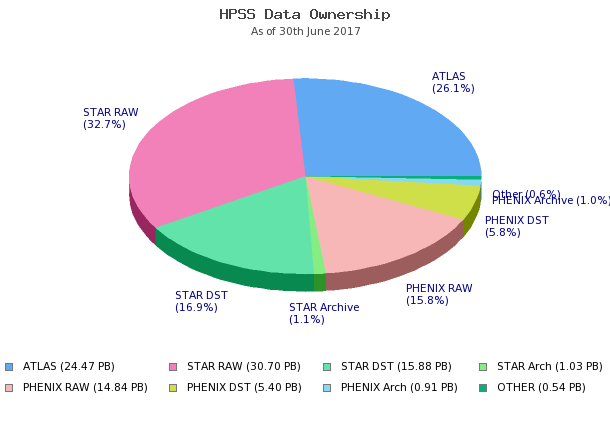 |
|
| Raw data growth for RHIC Run 17 | Current HPSS storage use by group & purpose |
Collaboration Members in the Headlines
Congratulations go out to the following STAR Collaboration Members:
- Rosi Reed, Daniel Brandenburg, Alex Jentsch, & Li Yi
-
Elected to the RHIC/AGS UEC:
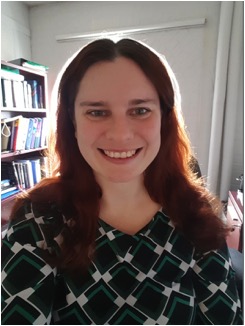
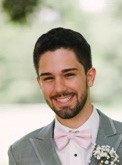
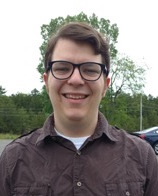
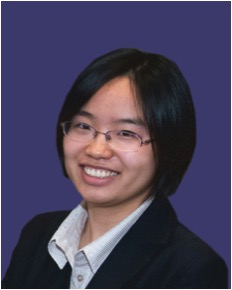
Rosi has been voted the Chair Elect and will become the Chair next year following STAR's own Jim Thomas (who also succeeds a STAR member in Lijuan Ruan, now the past chair). Daniel, Alex, and Li have been voted as student/postdoc members with 1 year terms. STAR has several other members on the UEC; the member list can be found here. - Prashanth Shanmuganathan & Zilong Chang
-
Recipients of the 2017 RHIC & AGS Thesis Awards:
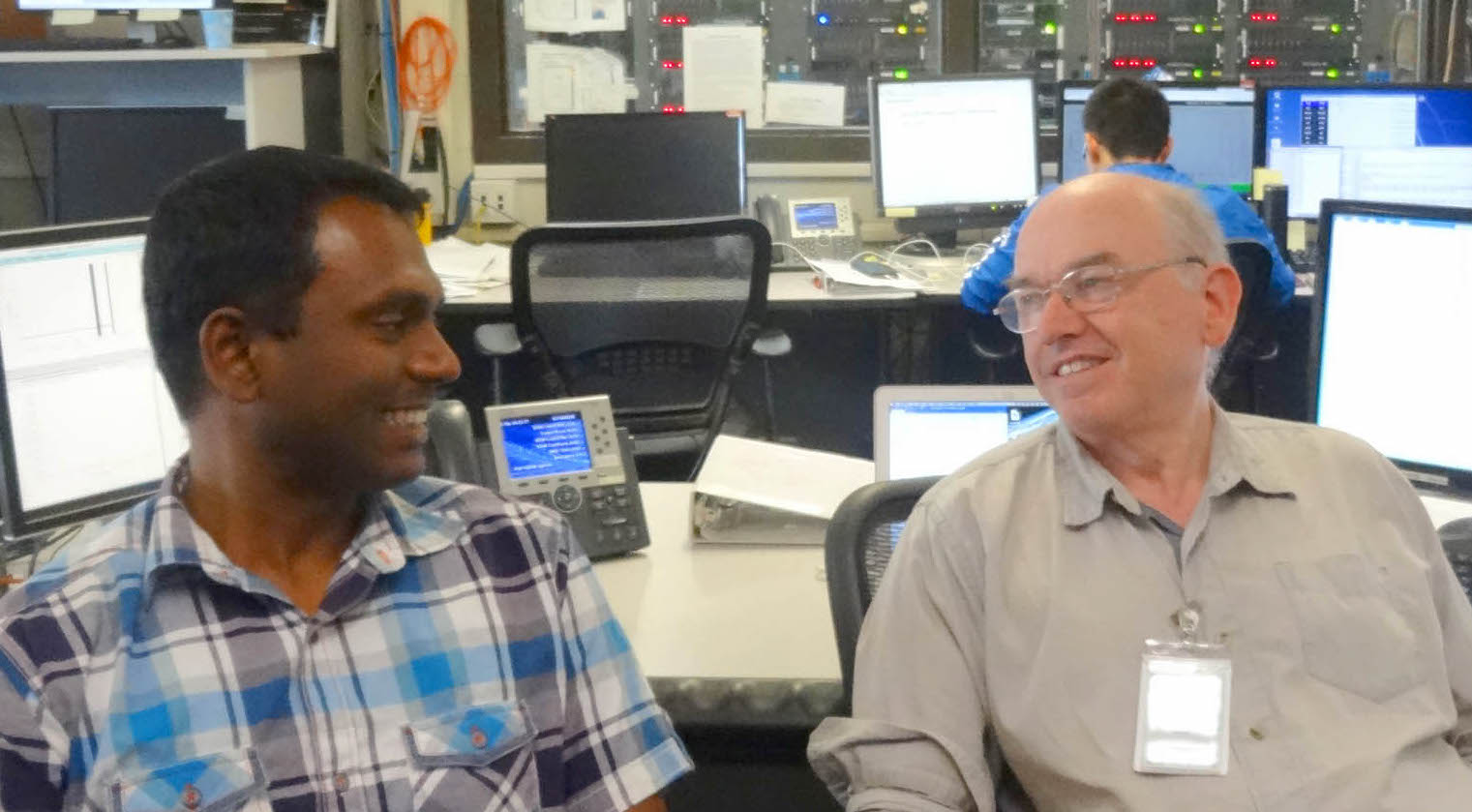
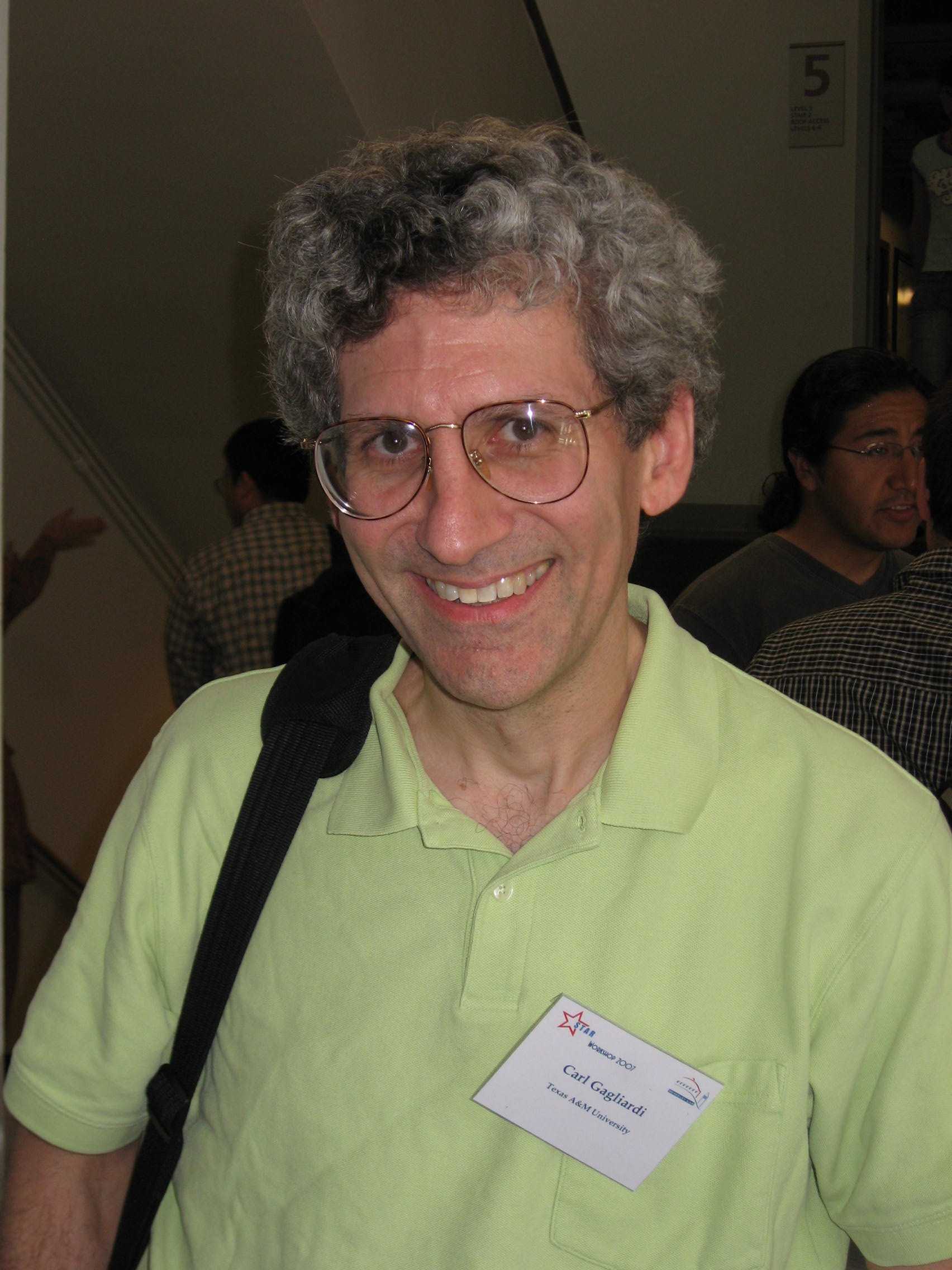
Prashanth's thesis (advisor: Declan Keane): First Moment of Azimuthal Anisotropy in Au+Au Collisions from the Beam Energy Scan at the Relativistic Heavy Ion Collider
Zilong's thesis (advisor: Carl Gagliardi): Inclusive Jet Longitudinal Double-spin Asymmetry ALL Measurements in 510 GeV Polarized pp Collisions at STAR
Prashanth and Zilong presented their work in posters & flash talks at the 2017 RHIC/AGS Users' Meeting. Their theses will be featured on the RHIC/AGS UEC's website (here). - Devika Gunarathne
-
Recipient of the 2017 Temple University Outstanding Research by a Graduate Student Award:

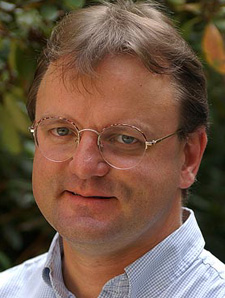
Devika's thesis (advisor: Bernd Surrow): Measurement of the Longitudinal Single-Spin Asymmetry for W+/- Boson Production in Polarized Proton-Proton Collisions at \sqrt{s}=510GeV at RHIC
"Devika's accomplishment are impressive and her excellent work is a positive reflection not only of herself, but of her department, the College, and the entire Temple community."Michael Klein, Dean, College of Science and Technology, Temple University (paraphrased) - Michael Lomnitz
-
Recipient of the 2017 RHIC & AGS Users' Meeting Poster Award:

Michael's poster (advisors: Spyridon Margetis and Xin Dong): D0 Elliptic and Triangular Flow inAu+Au Collisions at RHIC
STAR arts
(Mike Lisa - OSU)
This is a recently introduced feature we're trying with the STAR Newsletter for Collaborators to contribute something creative/artistic that relates to STAR. This could be a really cool looking graph generated from some analysis, or a striking photograph. The idea is akin to the "Back Scatter" feature of Physics Today (example), or the Picture of the Month of CERN Courier (example). Please feel free to have fun with this and consider making a contribution yourself for the next edition!
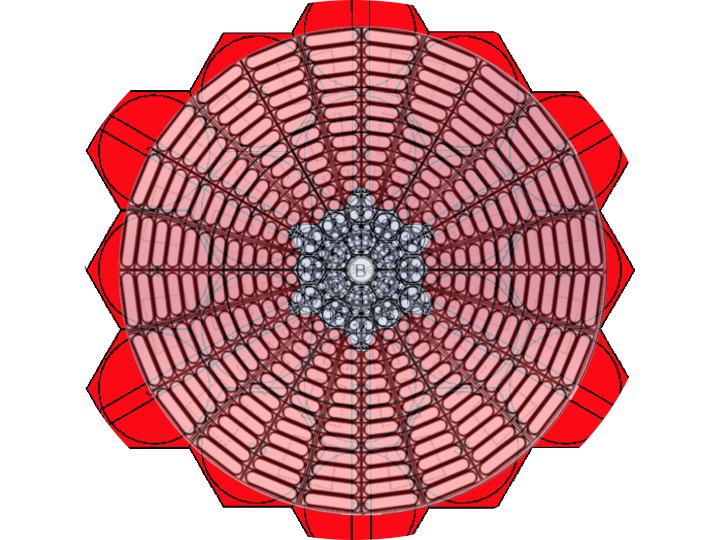
Overlay of BBC (red) and EPD (white) detectors
Previous Edition: April 2017
Groups:
- Printer-friendly version
- Login or register to post comments


